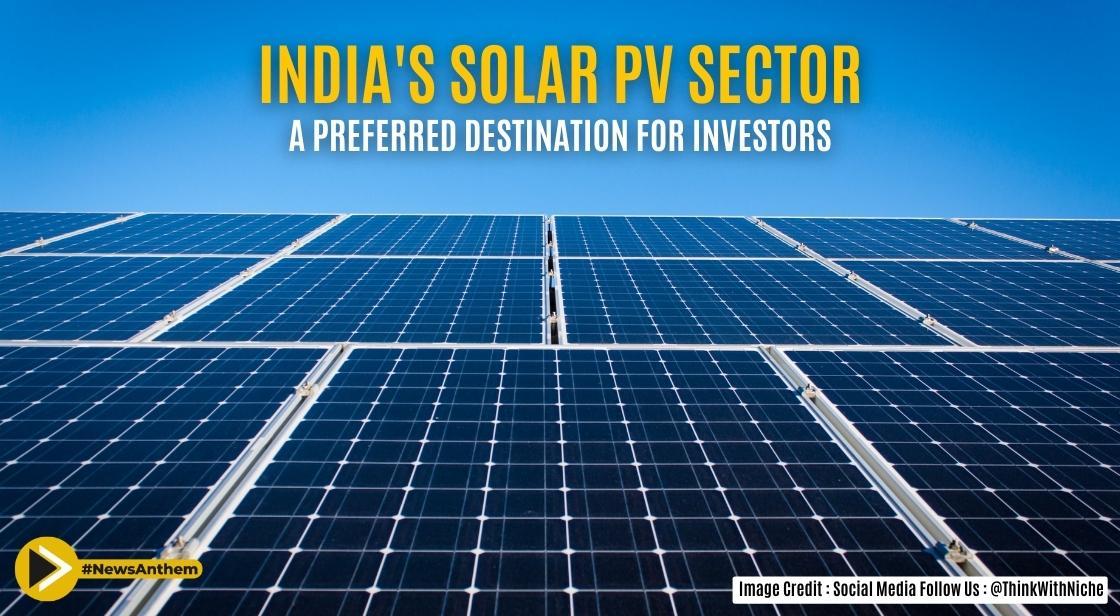India Solar PV Sector: A Preferred Destination for Investors

News Synopsis
Solar PV Sector in India Emerges as Prime Investment Destination, Attracts Global Investors
India, now the world's most populous country with over 1.4 billion people, is experiencing rapid economic growth. Meeting the energy demands of this expanding population has become a key priority for the Indian government. With a vision of becoming a net-zero economy by 2070, India aims to increase the contribution of renewable energy sources.
The government has set ambitious targets, including achieving approximately 50% cumulative electric power installed capacity from non-fossil fuel-based resources by 2030.
Impressive Growth Projections for Solar Power
According to the Central Electricity Authority, India's installed power capacity is expected to reach 800 GW by 2029-30, with non-fossil fuel sources accounting for over 500 GW. Solar power is projected to play a significant role, contributing more than 270 GW to the overall capacity.
In line with this objective, the government has introduced the Production-Linked Incentive (PLI) scheme to encourage solar manufacturing in India. These policy initiatives have attracted active participation from both domestic and international investors in the solar sector.
Global Investor Focus on Climate Consciousness
The global investor community has shown a growing awareness of climate change and sustainability. Following the Paris Accord, sustainable financing taxonomies have emerged, helping investors identify activities that contribute to sustainable goals.
Sustainability has become a key criterion for investment decisions, resulting in higher flows into renewable energy compared to fossil fuels.
Despite challenging economic conditions, the renewable sector continues to attract significant investments. In 2021, global new investment in renewable power and fuels reached USD 366 billion, with solar PV accounting for 56% of the total.
India followed this trend, with total new investment in renewables reaching USD 11.3 billion, with solar PV accounting for approximately 66%.
Funding Opportunities in the Solar PV Sector
The Solar PV sector in India offers an attractive business proposition, providing predictable cash flows compared to traditional infrastructure projects. Long-term Power Purchase Agreements (PPAs) with Public Sector Undertakings (PSUs) and highly-rated corporates help mitigate offtake risks.
This makes solar projects appealing to both fixed-income and equity investors. On the debt side, power sector-focused financing institutions, domestic banks, and Non-Banking Financial Companies (NBFCs) find the sector attractive for term lending opportunities.
The shorter gestation period, lower execution risks, government policy support, and long-term offtake arrangements make solar projects a unique proposition for lenders. Multilateral development financial institutions, such as the World Bank and the Asian Development Bank, have specialized schemes to support the solar sector.
Diverse Financing Avenues for Solar PV Projects
The green bond market provides another avenue for solar plants to raise funds. This concept, popular in developed markets, is gaining traction in India as well. SEBI's data on green debt issuance reveals that, as of September 2022, 15 Indian entities have issued green bonds, raising more than INR 4,500 crores, with a significant portion coming from the renewable energy sector, particularly solar PV generators and financers.
The Government of India has also announced the issuance of sovereign green bonds, providing impetus to public sector renewable energy projects. Additionally, structures like infrastructure investment trusts can be utilized to monetize operational solar PV assets.
Investor Landscape in the Solar PV Sector
The Indian solar PV space has witnessed interest from both financial and strategic investors. Sovereign wealth funds, pension funds, and private equity funds are attracted to the sector for long-term returns, aligning with the global energy transition theme.
Strategic investors, including oil and gas companies and thermal power generators, view solar PV as an extension of their existing business and a pathway to maintain leadership in the future fossil-free energy sector.
Multiple deals involving strategic partnerships, buyouts, and portfolio asset sales have taken place in the Indian solar PV space in recent years.
Global multinational corporations are also heavily investing in the Indian solar sector to decarbonize their operational footprint and achieve net-zero targets.
Growth Potential and Investment Preference
The solar PV sector in India presents significant growth potential, driven by the global energy transition theme, climate-sensitive investment frameworks, government support, and favorable economic and demographic factors. With its long runway for growth, the solar sector is expected to remain a preferred investment choice for domestic and international investors within India's broader renewable energy space.
Conclusion
The solar PV sector in India has emerged as a preferred destination for investors, driven by government policies, sustainability goals, and attractive business prospects. With India's ambitious targets to increase the contribution of renewable energy sources and become a net-zero economy by 2070, the solar sector is set for significant growth.
The Indian government's focus on renewable energy, updated targets, and the introduction of the PLI scheme have attracted active participation from both domestic and international investors. \
The global investor community's increasing climate consciousness and sustainable investment frameworks have further propelled investment flows into the renewable energy sector, with solar PV leading the way.
The solar PV sector in India offers an appealing business proposition, with predictable cash flows and manageable offtake risks through long-term PPAs. Various financing avenues, including debt financing from power sector-focused institutions and green bonds, provide opportunities for raising capital.
Additionally, equity investors, including financial and strategic players, see the solar PV sector as a lucrative investment option, driven by the energy transition theme and the decarbonization efforts of multinational corporations.
With a long runway for growth, supported by favorable economic and demographic factors, regulatory backing, and global energy transition trends, the solar PV sector in India is positioned to remain a preferred choice for investors within the broader renewable energy space.
As India continues its journey towards a sustainable and clean energy future, the solar PV sector stands as a promising and lucrative investment opportunity, contributing to both environmental goals and economic development.
You May Like









